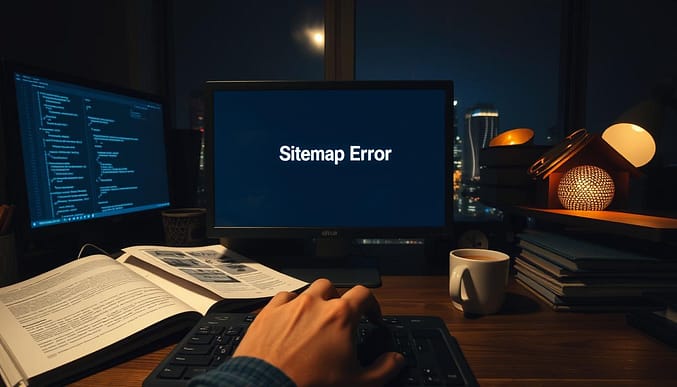Fix Google Search Console Sitemap Couldn’t Fetch Error
When managing your website’s visibility, encountering a “Couldn’t Fetch” notification for your sitemap can disrupt indexing efforts. This error occurs when crawlers fail to access your XML file, directly impacting how pages appear in results. Proper sitemap configuration ensures search engines efficiently crawl and prioritize your content.
Issues like incorrect file formats, server downtime, or misconfigured security settings often trigger this problem. For example, discussions in technical forums highlight cases where firewall blocks or oversized sitemaps caused persistent errors. Resolving these requires methodical checks, such as verifying file locations and adjusting platform settings.
Understanding the root cause is critical. A functional sitemap helps algorithms distinguish legitimate content from spam, affecting overall rankings. Tools like live URL tests provide immediate feedback to validate fixes. Without accurate data, your site risks slower indexing or incomplete visibility.
Key Takeaways
- The “Couldn’t Fetch” error blocks search engines from reading your sitemap, harming SEO performance.
- XML file placement in the root directory and proper formatting are essential for accessibility.
- Server errors, oversized files, or security restrictions often cause this issue.
- Verification through methods like HTML tags or DNS records ensures crawler access.
- Regularly test URLs to confirm fixes and maintain indexing efficiency.
Understanding the Error in Google Search Console Sitemap
A sitemap error in your dashboard can halt your site’s discoverability. The “Couldn’t Fetch” alert means crawlers can’t retrieve your XML file. Without this roadmap, search engines struggle to index new pages or updates efficiently.

What Does the “Couldn’t Fetch” Error Indicate?
This error often points to technical barriers. For example, a user on a WordPress support thread discovered their firewall blocked crawler access. Security plugins or server configurations might restrict XML file retrieval. Outdated robots.txt rules can also misdirect crawlers, causing them to skip critical pages.
Impact on SEO and Website Visibility
Unresolved sitemap issues delay indexing, harming search rankings. If crawlers can’t read your XML file, they may overlook fresh content or prioritize outdated pages. Over time, this leads to lower visibility and fragmented traffic.
Forum replies highlight cases where misconfigured security settings caused weeks of indexing delays. Regularly check your Search Console for error updates. Caching glitches or conflicting plugin updates can reintroduce problems, so consistent monitoring is key to long-term SEO health.
Effective Fixes for “google search console sitemap couldn’t fetch” Error
Resolving technical roadblocks requires precision. Start by confirming your XML file meets basic accessibility requirements. Many website owners overlook simple formatting issues that trigger validation failures.

Step-by-Step Guide to Resolve the Issue
1. Verify sitemap structure: Ensure your file name uses lowercase letters and ends with .xml. Avoid special characters or spaces. Test the URL format – both trailing slash variations (yourdomain.com/sitemap.xml vs. yourdomain.com/sitemap_index.xml) work, but consistency matters.
2. Adjust platform configurations: In WordPress, navigate to Settings > Reading. Uncheck the “discourage indexing” checkbox. This oversight often blocks crawlers from accessing critical files.
3. Modify caching rules: Most optimization plugins cache XML files by default. Create an exclusion rule for your sitemap URL in caching settings. Popular tools like WP Rocket and LiteSpeed have dedicated fields for this purpose.
Validating Changes and Monitoring Results
After implementing fixes, use the live test tool in your dashboard. Check the HTTP status code – a 200 response confirms successful retrieval. One user reported their URL indexing best practices reduced errors by 80% within 48 hours.
Monitor your dashboard daily for updated status reports. Residual issues might surface if pages contain conflicting ‘noindex’ directives. Run a site-wide audit using free tools to identify hidden conflicts.
Advanced Troubleshooting and Additional Considerations
When initial solutions fail, advanced diagnostics uncover hidden barriers affecting sitemap accessibility. Technical conflicts often lurk in server environments or CMS plugins, requiring targeted strategies to restore crawler communication.
Checking Firewall and Plugin Configurations
Firewalls sometimes block crawler IP ranges by default. A webmaster forum user reported their XML file became accessible after whitelisting Googlebot’s IP blocks (64.68.90.* and 66.249.64.*). Check your security logs for repeated 403 errors during crawl attempts.
Caching plugins frequently cause issues. One case study showed a WordPress site’s sitemap displayed outdated URLs due to aggressive page caching. Exclude your sitemap URL from caching rules in tools like WP Rocket or W3 Total Cache.
Analyzing Robots Directives and URL Settings
Review your robots.txt file for unintentional blocks. A misplaced Disallow: /sitemap.xml directive can override proper indexing. Use the robots.txt tester to validate permissions for critical files.
| Tool | Function | Quick Fix |
|---|---|---|
| Security Plugins | Block crawler access | Whitelist Googlebot IPs |
| Caching Systems | Serve outdated XML | Exclude sitemap URLs |
| Robots Meta | Override indexing | Remove ‘noindex’ tags |
Virtual robots-x files in CMS platforms can conflict with standard directives. Run a site:domain.com search to verify indexed pages match your XML entries. Persistent errors may require manual URL inspection through your dashboard’s coverage report.
Conclusion
Resolving the “Couldn’t Fetch” alert restores your site’s roadmap for search engines, ensuring content reaches its audience. This error disrupts indexing efficiency, potentially delaying rankings for new pages or updates.
Follow the outlined steps systematically. Verify XML file structure, review server settings, and test security configurations. Many users in technical forums confirmed success after adjusting firewall rules and plugin permissions.
Post-resolution monitoring remains critical. Check your dashboard daily for updated status reports. Community discussions highlight how minor caching tweaks or robots.txt adjustments often finalize the fix.
Special thanks to contributors in support threads whose troubleshooting insights shaped these solutions. With precise adjustments, your sitemap will function smoothly again, maintaining consistent visibility.
For ongoing maintenance, bookmark trusted guides or join webmaster communities. Proactive checks prevent recurring issues, keeping your digital presence optimized for long-term growth.